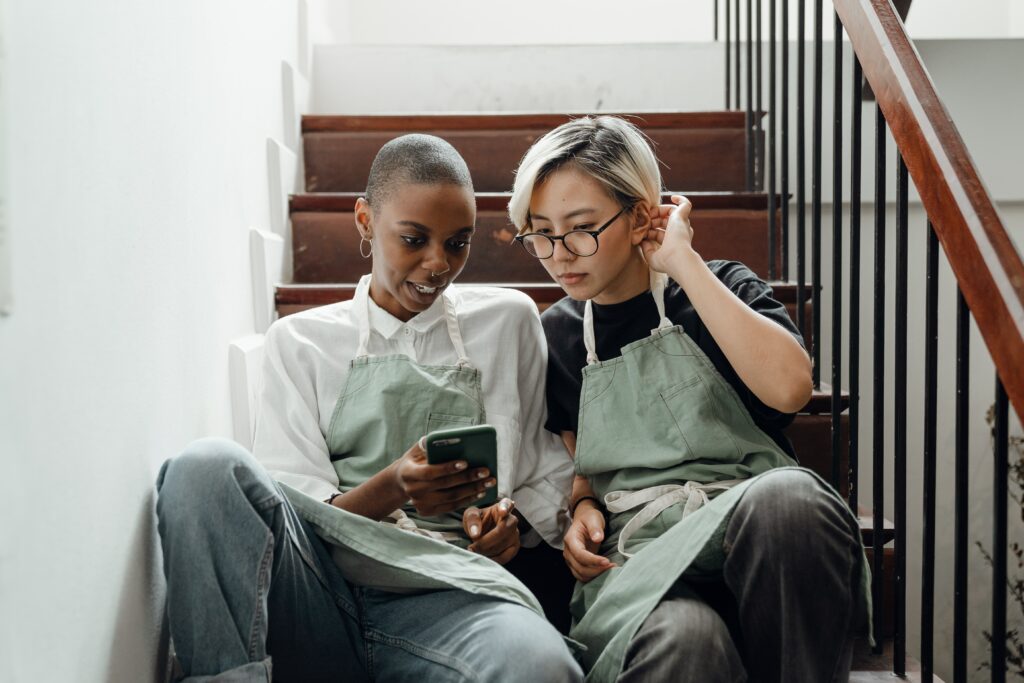When building an app or developing a concept for an app your main concern is probably to make it successful and profitable, basically to make your idea fly. Designing your app as inclusive and diverse as possible is perhaps not always in your mind. However, creating a diverse app that treats people equally can have a huge impact on those people and on how your company is perceived.

Why words matter – the philosophy
One way to do this is to think about your language, because words do have an immense impact on our thoughts and perception of the world. Philosopher of language Ludwig Wittgenstein had the insight that the limits of one’s language are the limits of one’s world. That means that our language determines our reality or in other words, that language defines us. Language shapes the way we think. [1] Conversely, this means that by changing our language we can change ourselves and the world around us. It seems to be a good thing to reflect on your own language. By doing that, we maybe change something for the better. One example is the slight movement that happens in the tech industry at the moment: The discussion and changes in the context of the former ‘master branch’ which is now called different in many big tech companies. [2]
Are we losing our language?
Some people seem to have a vague fear of losing their language if they are “not allowed” to use certain words anymore. Part of this argument is always the ignorance of the fact that words are never just words. They happen as a part of our society and history. Some words reflect injustice that happened in the past and till this day. Good news is that we are not losing our language just by avoiding racist, sexist and other discriminating terms. [3] Quite the opposite: We actually win the ability to use a more inclusive and diverse language. Thereby we even make the world a little better.
Awareness of language – the benefits
By being aware of our language we cannot just have a positive impact on the outside world. It also affects our inside world, meaning our body and mind. A study shows that negative words, whether heard, thought or spoken can cause stress and anxiety. The good thing is that positive words have at least as much influence as negative ones. So, the exercise of positive thoughts can really change people’s reality. By doing this consequently, certain parts of the brain are trained. That effect changes our perception of the self and the world around us. Accordingly, at least as much as negative words can hurt and cause damage, positive words have a great impact on people’s lives and the world. In a business context, there are some specific terms that can be shifted towards positive language. For example, use ‘capability’ instead of ‘process’ or replace ‘accountability’ with ‘shared ownership’. [4]

Where can we improve – examples
Before looking at how to consciously create inclusivity in apps, let’s peek at situations where inequality is (often accidentally) enabled. For instance, according to a research from Cracked [5] the vacation rental company Airbnb is confronted with the following situation: Some renters would rather let their flats empty (and don’t earn money) than renting them to Black people. Users with “stereotypical black” names are more often rejected when applying for an accommodation than users with “stereotypical white” names. And not least Black people have to charge 12% less for their homes of similar sizes in similar locations to get a renter.
To be fair, Airbnb removes users who got complaints and is always updating their nondiscrimination policy. However, it’s also faced with the apparent dilemma of enabling inclusivity without forcing people to rent out to anyone requesting it. So the question arises: How to create an inclusive, yet streamlined process? Also, do you want people to end up in a situation where they will potentially face harassment or discrimination at a place where they rent a room?
Too old to be single?
Another situation where we’re confronted with the potential for discrimination can be found in dating apps. Some apps seem to particularly enable discrimination. For example Tinder, which can be used for free. But it offers a fee-based app version as well, which has some extra features. The problem was that there were two different price levels, depending on the age of the user: People under the age of 30 had to pay $9.99 per month, while everybody above 30 (or 28 in Europe) had to pay twice as much. The company explained this by saying that younger people usually have less money than older people and are therefore less charged. [6] One could also call that ageism that plays with the fears of people who aren’t in a relationship.
Racism in dating apps
Another big problem about dating apps is the immanent racism they enable or tolerate, even if they don’t encourage it. For example Grindr had an ethnicity filter, until the pressure due to the Black Lives Matter movement became too big. [7] But still racism is an issue in dating apps like Grindr or Bumble. Users have reported that they got offensive and discriminatory messages after other users had found out that they are People of Colour. Most people wouldn’t say or even tolerate such racist insults in real life anymore, but in dating apps it seems we still put up with them.
Activists say that as long as the operators don’t do anything against discriminatory behaviour in their apps, they are normalising racism on their platforms. “The apps have the resources and should be capable of holding people accountable when they behave in a racist or discriminatory way. If they choose not to, they’re complicit in that.” [8]

How to create inclusive apps
Obviously, now you are asking yourself how to make it better. It definitely makes sense to have the attempt of creating an inclusive app. Not just for social reasons, but also for business reasons. Being inclusive and using inclusive language has an impact on how your users see themselves represented and supported by your product. From this it follows that they might leave if they don’t feel represented or addressed. You might also want to consider that a diverse team for one thing has an eye for creating inclusive products, for another thing diversity and inclusion in the workplace lead to better business performance. [9]
One could argue that there was less discrimination in the early days of the internet, since companies had less information about their customers at their hands. Nowadays, there is no excuse for any company not to be aware of racial discrimination in their product. Apps like Airbnb or Uber demand information about their users, such as photos and names. What can you do to minimize the risk of discrimintaion in your app? Try to integrate the following subjects into your design decisions. They are especially important for online marketplaces, but even so useful for every app.
Information provided
You should seek to withhold information such as race and gender until after a transaction (or decision) has been agreed to. In some cases, such as dating apps or ride sharing, it should be streamlined to withhold information about the user that refers to their demographics, while only sharing reviews.
Ratings and automatic reviews
Be sure to implement functions like rating and automatic reviews. For example on a platform like Airbnb: If someone always rejects a certain demographic, then they automatically get flagged for review and removed or blocked from the platform. Think as well about implementing reporting mechanisms for serious review.
Automation of the process
Build in features such as ‘instant book’. They allow the customer to sign up before they have seen the name or photo of the seller or renter. This can reduce discrimination while increasing convenience. But also be aware that it might be important information for users, since you don’t want to put them in danger by booking a flat of a racist person or the like.
Emphasizing non-discrimination policies
Present them as soon as possible, for example during the actual transaction process, rather than just in fine print. That makes them less likely to be broken. Also, point out that users will be blocked if they violate these non-discrimintaion rules.
Awareness for discrimination
Track repeatedly how race or gender affects the user experience and always seek to minimize the risk of discrimintaion in your app. [10]
Use welcoming language
There are even more things you can do to create an inclusive app. Once again, language is really important. For example, use welcoming language. Try to use plain and easy language that everybody is able to understand. That means not to use colloquial expressions or specialized and technical terms without explaining them. Also be careful when using humour – not everybody shares your humour and it can be difficult to understand it in other languages or cultures.
Be aware of gender identity
Attempt to avoid unnecessary gender references. If possible, always replace pronouns like ‘her’ and ‘his’ with the non-gender-specific ‘their’ or avoid pronouns at all and use words like ‘customers’ or ‘subscribers’. When using icons make them look like a generic person, not like a woman or man. Most apps don’t need to know their user’s gender at all. In case your app does need it, for example for health or legal reasons, consider providing inclusive options such as ‘non-binary’ or ‘decline to state’.
Avoid stereotypes and generalizations
Be aware of your own biases and try to address as many different people with various living conditions. For example, your app requires people to choose security questions they can answer for future identity confirmation. Don’t use questions like ‘What was your favourite subject in college?’ or ‘What is the maiden name of your mother?’. Not everybody went to college and the assumption that the user’s mother is married may make them upset or unhappy. Better use questions like ‘What quality describes you best?’ or ‘What is your favourite hobby?’. [11]



